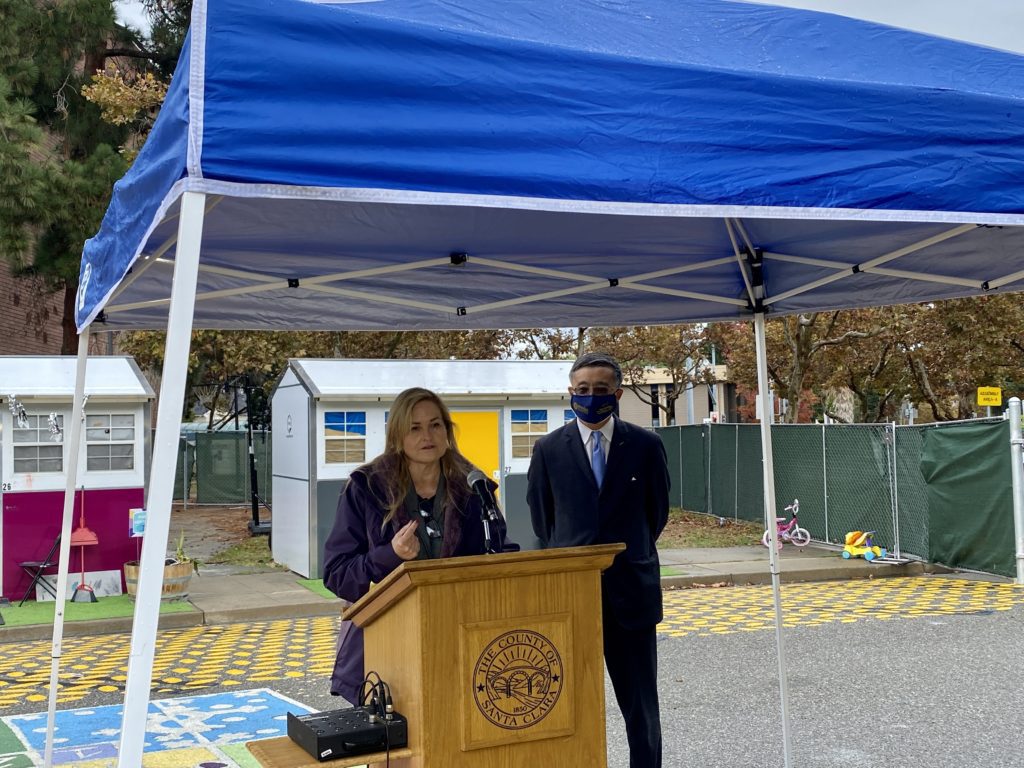Local lawmakers are racing to build more emergency housing amid a growing homelessness crisis, but where these sites will go is still undecided.
A pair of Santa Clara County officials want to use vacant or underutilized lots for a new temporary housing or safe parking site. The plan is to replicate the Casitas de Esperanza prefabricated housing project at the Civic Center—an interim housing site for families that opened earlier this year.
“In a perfect world, I’d want all of our money to be going into supportive housing,” Supervisor Cindy Chavez said Monday. “However, we all know that we’re in a crisis and permanent housing isn’t being built fast enough.”
The proposal, spearheaded by Chavez and Supervisor Otto Lee, asks the county to identify appropriate sites, available funding and estimated developmental and operational costs. If approved by the Board of Supervisors on Tuesday, the county will come back with potential locations in December.
“We want to be relatively quick,” Lee told San José Spotlight, adding that the county is counting on state funding to support new housing sites. “(Project HomeKey) funding from the state is not infinite.”

Facing an exploding homelessness crisis, San Jose and Santa Clara County lawmakers have looked at some unorthodox options to build temporary housing, including churches, a police department parking lot and land by highway on-ramps.
In September, Santa Clara County approved a multi-million contract with LifeMoves, the region’s largest temporary housing provider, to replicate an existing shelter site made out of shipping containers in Mountain View at 10 other locations across the county.
The new effort will look for a site specifically for a tiny home community, Lee said.
“We’re not leaving any stone unturned,” he said of the county’s many efforts to shelter its unhoused residents. “I’m not supporting one versus the other. Whichever works for your neighborhood or the piece of land that you have, that’s the type of project we want.”
In September, San Jose Mayor Sam Liccardo, backed by six councilmembers, unveiled a plan to cut the homeless population in the city by 20% through prefabricated housing. The council then approved a prefab housing project in a parking lot at the San Jose Police Department headquarters in early October.
Building more interim housing is a solution that could get unhoused residents off the streets within months, county officials said. San Jose added more than 300 interim housing units to three different sites across the city during the COVID-19 pandemic—with more in the works.
Prefab housing is faster to build and much cheaper than permanent housing, officials said. Temporary housing costs roughly $100,000 to $110,000, compared to a price tag of $750,000 for permanent housing.
According to a 2019 survey, the number of unhoused residents reached a record high of more than 9,700 people in Santa Clara County. It’s unclear how many are living on the streets because the county canceled its biennial count due to the pandemic, but advocates say the issue has only gotten worse.
In February, Santa Clara County opened a community of 25 tiny homes at 801 N. First Street to serve up to 100 people. Each unit is equipped with four foldable bunks that can double as tables, shelving, a space heater and an air conditioning unit.
Laura Delgado, program director for Amigos de Guadalupe which manages the tiny home community, said the site is home to 21 families who can stay up to six months until they find permanent housing or a job.
Case managers build relationships with each resident through a “radical hospitality” approach, Delgado said.
“They know this is interim housing,” she said. “But they know that this is their community. This is their home for the time being.”
At least four families at the site have found permanent housing since February, Delgado told San José Spotlight.
“We don’t tell (families) what their goals are, instead we asked what they want their life to be,” she said. “We will partner with them and will help them meet those goals.”
Contact Tran Nguyen at [email protected] or follow @nguyenntrann on Twitter.



Leave a Reply
You must be logged in to post a comment.